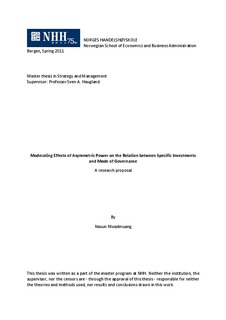Moderating effects of asymmetric power on the relation between specific investments and mode of governance : a research proposal
Master thesis
Permanent lenke
http://hdl.handle.net/11250/169293Utgivelsesdato
2011Metadata
Vis full innførselSamlinger
- Master Thesis [4372]
Sammendrag
This master thesis is a research proposal focusing on the extent to which asymmetric power
impacts the effects of specific investments on governance mode. Williamson’s (1975, 1981,
1985, 1991a, 1991b) transaction cost economics (hereafter, TCE) has been a leading theory
of inter‐firm governance. Although TCE has received widely recognition, it has been subject
to criticisms. One of which I pay particular attention is its empirical validity and applicability,
since TCE seems to give insufficient explanation on mode of governance used in asymmetric
power relationships.
TCE focuses on the dichotomy between market and hierarchy. However, researchers critique
that TCE overstates the desirability of partners on integration and explicit contract. In facts,
firms conduct collaborative exchange which is neither market nor hierarchy (Dyer, 1997).
Moreover, Geyskens’s et al. (2006) meta‐analysis shows that studies support that as asset
specificity increases relational governance becomes preferred over market governance. In
general the logic is the same with original TCE that if specific investments are high, an
investing firm exposes itself to its partner’s opportunisms, so that a firm needs to safeguard
such investments. In this proposal I incorporate relational governance in the model to
improve TCE’s ability to explain the relation between specific investments, firm power, and
mode of governance.
Asymmetric power is hypothesized to increase the degree of hierarchical governance when
specific investments are deployed by the stronger firm in a dyadic relationship because a
stronger firm will exploit its weaker partner (Bannister 1969; Robicheaux & El‐Ansary 1975)
by prescribing its weaker partner to agree with a contract that governs both parties to work
more closely than usual, enabling the stronger firm to gain more protection of its assets at
risk, and increase its access to the weaker partner’s information (Dwyer & Walker, 1981;
Frazier & Rody, 1991; Frazier et al., 1989; Heide & John, 1992; Kale, 1986; Roering, 1977;
Wilkinson & Kipnis, 1978). On the contrary, asymmetric power is expected to lower the
degree of hierarchical governance when the investing party is the weaker party in the
relationship. A stronger partner is likely to prefer market based governance because it can
gain benefits from market competition when it has no assets at risk (Williamson, 1985). A weaker firm is prone to accept a high tolerance level for the use of power by its strong
partner (Bucklin, 1973; Blalock and Wilkin 1979).
On the other hand, symmetric power where two parties possess the same levels of power is
hypothesized to increase the degree of relational governance when both parties hold mutual
specific investments. TCE suggests that under such conditions firms will tend to employ
integrated governance to safeguard their specific assets and reduce transaction costs.
However, under such conditions it seems hard to develop hierarchical governance where
one party will have a legitimate authority to direct another party because both parties
possess the same degree of power. They are, therefore, likely to employ relational
governance that expresses the sentiment of joint responsibility (Cannon et al., 2000).
Moreover, under relational exchange both partners can avoid high costs of establishing and
maintaining the bilateral contract (Harrigan, 1983).
Expected contribution of this research is to improve TCE’s ability to explain make, buy, or ally
decisions across exchange partners. Other constructs may be needed to augment TCE
perspective. This research proposes that TCE should be augmented with a construct of
asymmetric power.
